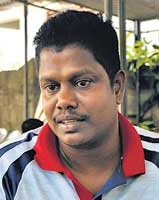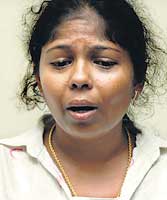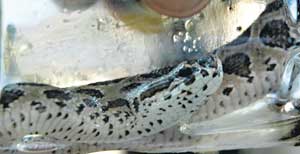
No venom, only sorrowAs grieving parents try to come to terms with the death of their little girl from a snake bite, the question they ask is could it have been prevented. Little girls in white uniform and blue tie troop in solemnly and bow their heads in prayer. They are paying their last respects to a classmate who the week before studied with them, played with them and laughed with them, but now lies before them……..dead, her tiny body draped in white and her head and face covered with a gossamer white veil. Six-year-old Madelina is dead from a snake bite, not in a remote part of the country, but in the bustling town of Wattala and ironically after the parents did the right thing, taking her to the closest but at the same time premier hospital in the area, the Ragama Teaching Hospital. The day before the funeral, last Tuesday, when The Sunday Times visited her home her parents were distraught and weeping. “She stepped out from here with her brother, to eat a piece of cheese at about 2.30 in the afternoon,” says father V. Manoharan, deep sobs wracking his frame, pointing to the side of the house close to which is the boundary wall.
Thereafter, events which were tragically to change their “complete” little family of father, mother, daughter and son occurred quickly. There was a shout of pain from Madelina, for she had been bitten by a sarpaya. The parents rushed out, the small snake was still there. Someone covered it with a kude. The father carried Madelina into the house, washed the puncture wounds clearly visible just below her left ankle gently with soap and water and tied a tourniquet, grabbed the jam bottle into which the snake had been coaxed, and rushed to the hospital. “She spoke to us all the way there, reassuring her mother and me that she was alright,” says Mr. Manoharan. The child was taken to the hospital’s Accident Service but from there, according to Mr. Manoharan, as there was no room at the Intensive Care Unit, she was sent to Ward 2. Alleging negligence, many are the flaws he says he and his wife, Jenita Ratnam saw and heard. Oxygen being given to their daughter when the tube was not fixed but was lying under the bed and the little one struggling to breathe; staff walking around and asking other patients whether they could identify the snake, when the parents were insistent that the neighbours had said it was a Russell’s viper or thith polonga; the child not being put into the ICU and even when a machine from there was brought to the ward arguments over whether it should be kept there or taken back to the ICU, the hospital’s Blood Bank staff not answering the phone; some queries whether the blood being given to the child was the right group; doctors mixing some green liquid while going through and checking with a book etc.…. For Jenita, indications that all was not right with Madelina came when she collected yet another sample of urine from her and found to her horror that it was bloody. The time was around 7.30 in the night and the child had been in hospital for several hours.The deterioration began soon after and the parents watched in shock as Madelina’s pulse and heart rate began dropping. The child was dead around midnight. The snake, however, is alive in the jam bottle that is being kept at the family’s home. The child is dead and has been buried, but the questions and issues are many (see box), foremost being whether there was negligence on the part of the hospital.
“According to the mother, the snake was hanging on to the child. So a big amount of poison may have gone into the body and even though we gave the anti-venom, it would not have reacted,” Ragama Hospital Director, Dr. R.M.M. Rajamanthri said. “The doctors and nurses were following guidelines,” he assures, adding that the parents’ claims of the Blood Bank staff not answering the phone and the oxygen tube not being attached were not true. The Sunday Times learns that the internal preliminary inquiry is being held by the hospital’s Deputy Director Dr. Lalani Gurusinghe.“Doctors were following treatment protocols. Blood clotting tests, both in the ward and the lab, and urine tests have been carried out. These were normal up to around 7.30 when the urine turned red,” she said when contacted by The Sunday Times, explaining that anti-venom had also been given to the child.
Dr. Gurusinghe said that she hoped to submit her report to the Director-General of Health Services by the end of the week after which the Ministry of Health would conduct a formal inquiry. However, Madelina’s father earnestly hopes that the fate of his little daughter would not befall any other. Pledging Rs. 100,000 to the Ragama Hospital to build a ‘unit to treat snake-bite’, Mr. Manoharan weeps: “I don’t want to go to courts. I don’t want any money. I just want this to be the last. Don’t want to let this happen to any other child.” A life is lost. Sadly it may have been a preventable death. What is deadlier: The bite or the anti-venom serum? A child has died of snake-bite at the Ragama Hospital. The child cannot be brought back to life whatever the recriminations. The urgent need is to check out what went wrong and take immediate measures to prevent another man, woman or child dying of snake-bite categorized as a "medical emergency". Statistics released by the National Poisons Information Centre reveal that around 100-150 people die of snake-bites every year even after admission to hospital, while about 40,000 are admitted to hospitals after being bitten. Another 100-150 people may be dying of snake-bite before being brought to hospital, it is believed. Little Madelina's death, therefore, makes us look deeper and harder at many issues that bureaucrats are accountable for:
The anti-venom which can be given for five types of snake-bites - Cobra, Common krait, Sri Lankan krait, Russell's viper and Saw-scaled viper -- is imported by the State Pharmaceuticals Corporation (SPC) from India which is also a tropical country, said SPC Manager - Imports, W.A.S. Wickramarachchi.
Explaining that the anti-venom has been effective here, he however, concedes that there could be snakes in Sri Lanka, especially in places like Anuradhapura and Polonnaruwa that are not found in India. "This particular anti-venom would not work then. However at the moment, there is no other anti-venom," he says adding that for 2008, an estimated 300,000 anti-venom vials, are to be imported, costing US$ 953,000. He assures that the anti-venom has been checked for quality."Sri Lanka does not have the technology or the resources to produce anti-venom. The process involves rearing snakes, getting their venom and injecting it into horses. We do not have the facilities to do these here; although discussions were held, they were not successful," he says. Stressing that Indian anti-venom is made from Indian snakes to ward off the effects of Indian snake-bites, snake expert Anslem de Silva says that the toxicity of the venom even of a Russell's viper in Colombo would be different to one in Anuradhapura or for that matter one in Gampola. He should know because, Mr. de Silva was the person way back in 1976 who did a survey on snake-bites in Anuradhapura and presented a paper at the first WHO World Conference on snake-bites held in Japan, indicating the high incidence of snake-bites in Sri Lanka. Later he had been commissioned by USAID to carry out a research on snakes for the government of Sri Lanka in the Mahaweli areas and also on the feasibility of producing anti-venom in the country. Explaining that it could have had a major impact on the treatment of snake-bite victims in Sri Lanka, he says not only would millions of dollars in foreign exchange been saved but also valuable lives. He believes that the number of imported vials needed to treat a snake-bite in Sri Lanka is much more than what is required in India. In 'Gypsy touch to combat snake-bite' The Sunday Times highlighted on April 21, 2002, a project to produce anti-venom in Sri Lanka. The treatment for poisonous snake-bite being the injecting of anti-venom serum to neutralize the venom in the blood, the fact that the Indian import did not fully clear the blood of victims of the venom had been established in 1985 in research conducted in Anuradhapura. Thus with the need for Sri Lanka to have its own anti-venom, the Colombo Medical Faculty had launched an initiative in collaboration with wildlife officials, to ultimately custom-make the anti-venom serum here or at least get it done from a country close by. As is usual in this country, everything has come to naught. The Sunday Times, meanwhile, understands that research indicates severe reactions to the Indian serum. One such research conducted in 1992 on 426 snake-bite patients who were administered the Indian import had found that 53% had "severe reactions" such as blood pressure drops, high fever, chills and rigors and difficulty in breathing. They almost died even after being given medication to lessen the reaction, it is understood. Another study done in Anuradhapura in 1997 on people who had been bitten by the deadly Russell's viper and given the Indian serum had shown an 81% reaction to it. There come the dangerous questions then: What killed the people who came to hospital on time after being bitten by a snake? Was it the snake-bite or the anti-venom serum? |
||||||||||||||
|
||||||
|| Front
Page | News | Editorial | Columns | Sports | Plus | Financial
Times | International | Mirror | TV
Times | Funday
Times || |
| |
Reproduction of articles permitted when used without any alterations to contents and a link to the source page.
|
© Copyright
2008 | Wijeya
Newspapers Ltd.Colombo. Sri Lanka. All Rights Reserved. |



